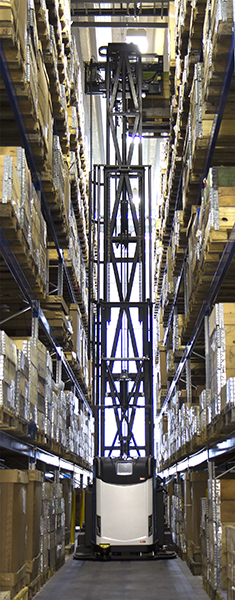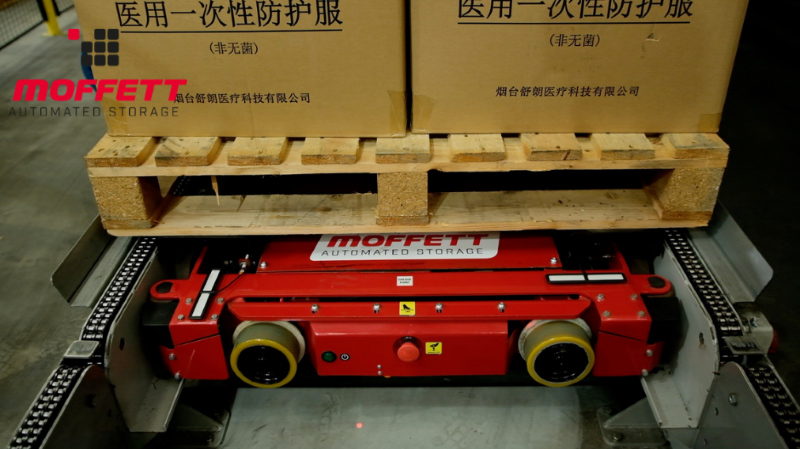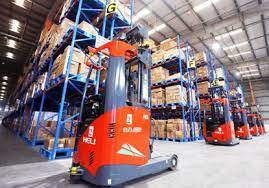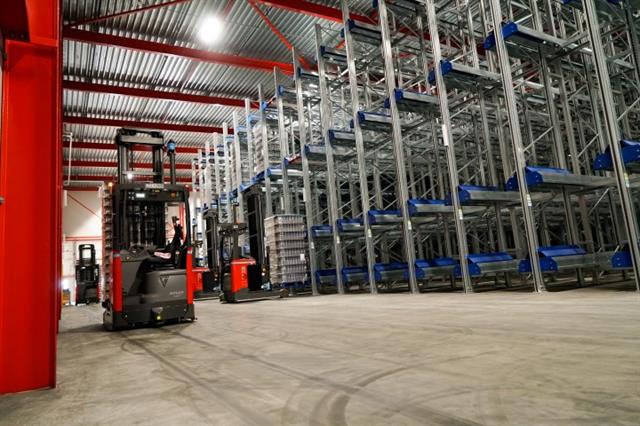Over the past decades, the big manufacturing, warehouse and logistics operations have been pro-active in taking up automation and r...
Over the past decades, the big manufacturing, warehouse and logistics operations have been pro-active in taking up automation and robotics, but small to medium-sized enterprises (SME) have been slower. Why is this the case and have things changed recently? What would encourage SMEs to take up the technology? Melissa Barnettlooks at some of the challenges and the solutions surrounding automation.
![]() Dave Sanborne senior vice president First Financial Material Handling & Automation |
Automation and robotics aren't for every business, but many are missing out on the benefits because of perceived obstacles. Adapting to automation calls for significant capital investment and disruption. As Kang Long, deputy general manager of Hangcha AGV, points out, it also requires a certain amount of 'informatisation and standardisation' that not all SMEs possess. For a number of reasons, the move to automation can seem daunting. However, the current global environment has increased the demand on warehousing and third-party logistics and opened opportunities for operational investment. Dave Sanborne, senior vice-president and national sales manager for First Financial Material Handling and Automation, says that the current explosive growth in e-commerce is causing major disruptions in logistics and placing a tremendous strain on everyone up and down the supply chain. Current events have also highlighted the uncertainty of labour availability and costs - and the need for stringent health and safety requirements.
![]() Rocla narrow aisle stacker AGV |
The only way to eat an elephant, says Petri Petäys, sales director of Mitsubishi Logisnext Europe, is one bite at a time. Petäys suggests automation can be implemented step by step. "The first step towards implementation is process standardisation. The second step is digitisation. Standardised and digitalised processes can then be automated," says Petäys. Kari Johansson, Logisnext solution management director, admits that automation is not the cure for everything. "Not all processes are suitable for automation, and it is important that the automation is easy to integrate and also modular to support the actual process needs. By analysing a customer's processes, we can find the best automation solution for their specific need," Johansson explains. This approach was recently used by Logisnext to assist a medium-sized company manufacturing different-sized steel products. After analysing the entire process together, it was determined that the company needed to fully automate its workflow and the storage system. "The biggest challenge was to find a supplier who could offer a solution for stacking pallets with heights that reach up to 7 m. It turned out the Rocla AGV was able to do that," says Johansson.
![]() Moffett Taxi |
Adam Montgomery, operations manager for Moffett Automated Storage, says it is possible for automated solutions to start small and still be cost effective. He suggests a staged installation, scaled over time to reduce pressure on upfront capital. "Our process begins with a consultation with the client to help understand their existing operation and its constraints and their required throughput, capacity and functionality," says Montgomery. Moffett recently completed a warehouse project for a medium-sized business in Ireland. The company's two main goals were to maximise storage and minimise labour costs and constraints. Montgomery says Moffett's final design allowed for 10,000 spaces for racking, an increase of pallet spaces by 58%, and installation of its Vertical Transfer Units and Moffett Taxis. The whole system, after commissioning of mechanical function and warehouse management software, took 10 weeks to install and complete.
![]() Heli AGVs |
Seasonal fluctuations have been a common problem in third-party logistics and continue to be difficult to predict, creating uncertainty in labour requirements for employers. Wang Yong, director of Heli Intelligent Vehicle Institute says that a Heli customer was finding it difficult to recruit forklift drivers during the peak production season, but didn't need so many drivers in the off-season. The business was also experiencing a high degree of stock damage Yong says that through face-to-face discussion with users and an in-depth understanding and analysis of needs, Heli proposed an unmanned warehouse implementation plan, retaining manual receiving and shipping, whilst unmanning inbound, outbound and in-store operations. This semi-automated plan significantly reduced loss of goods, reduced the impact of seasonal variability and ensured operations were efficient and economical.
![]() Cascade paper roll clamp on an AGV |
Mike Elmore, global product manager for Cascade Corporation, believes that the size of an operation should not prevent a company from exploring potential automation or AGV uses. "It is possible to start small and be cost effective at the size and scope you are able. With automated technology undergoing massive growth, it is important to look at the big picture and build foundational solutions that can evolve to meet future requirements," advises Elmore. One of the reasons that small to medium-sized warehouses don't take up automation is the space required to operate AGV or robotic equipment. Cascade recently implemented a creative solution for one of its clients, which called for pallet handling in a very narrow aisle application. "Cascade provided an electric Trilateral Head Attachment for an AGV that enabled the forks to turn left or right at 90 degrees, which greatly assisted precision loading on either side of the aisle in a tight space," says Elmore. A strategic plan for incremental growth is good advice and one that Tom Broeder, managing director of AGV International, recommends. "The move to automation in medium-sized businesses is definitely growing: these companies are requesting complete automated solutions just like corporate companies. It is especially evident in relatively new companies like LiveKindly, a growing vegetarian food company that we are helping to automate," says Broeder. AGV International has assisted LiveKindly with storage, racking, conveyors, iCUBE, forklift stackers and its warehouse management system. Broeder says that it is important that suppliers work with their customers in a pragmatic way, especially through the difficult, transitional 'brown field' stage. Frank Heptner, Linde Materials Handling senior director automation and intralogistics, believes that small and medium-sized companies are particularly successful in getting started with standardised solutions. "Using standard equipment enables individual tasks to be implemented without major project effort in existing infrastructures. If experience with initial projects is positive, more operational logistics processes can be automated step by step," he says. Linde has a range of automated industrial equipment, which does not require additional infrastructure to navigate freely in the environment, such as the three Linde L-MATIC pallet stackers which have been deployed at ebm-papst, a ventilation and drive technology manufacturer based in Germany. Major reconstruction work in the infrastructure was not an option for the company, so a solution which could integrate into existing applications with manually operated industrial trucks and pedestrians was implemented.
![]() Hangcha 2T mini-stacker AGV |
Vietnam is one of South East Asia's fastest-growing economies, with the government determined to make Vietnam an Industry 4.0 nation by 2030. Hangcha AGV has recently supported a Vietnamese tyre manufacturer towards this goal by providing not only AGV equipment but also WMS and AMS software for the factory floor. "We had a number of challenges during the project, including creating a compact design which is both flexible in narrow aisles and has controlled precision. The 22 2T mini-stacking AGVs , three 3T heavy-duty stacking AGVs, and three 4.5T flatbed AGVs all utilise the Hangcha SLAM natural navigation system for various docking situations in production line and storage locations, replacing the original manual operation, minimising manpower and increasing efficiency," says Long. The 2T mini-stacker AGV plays a particularly important role, he adds: "It is a compact and flexible design, with right-angle stacking aisle width of 2.2 m, and enjoys high precision control - perfect for logistics centres, warehousing and factories."The nuts and boltsFor SMEs, the optimal solution can often be achieved without full automation. Yong believes that the decision depends on the needs of the user and the competitiveness of the market in which the user operates. "If the site is only suitable for partial automation, then it is not economical to force full automation. We believe that the two may exist in parallel for a long time in a mutually reinforcing relationship," says Yong Johansson agrees that "a mixed-fleet solution combining the efficiency of automation and the adaptability of manual processing may be the most reasonable solution". Montgomery also believes that a hybrid solution can be beneficial in that it reduces the initial capital investment, but he cautions that such an option doesn't allow a business to capitalise on all the aspects of automation and reduces the flexibility available for scaling. For companies with high growth prospects, it is not always the best route to go, he suggests.
![]() AVG International |
Hybridisation not only refers to processes, but can also be applied to equipment. "AGV International does conversions of standard materials handling equipment from leading manufacturers, as well as new automated guided vehicles. We think that a 'dual-drive' solution is a strong and growing market - all the major players are proposing these kinds of solutions," says Broeder. There is still room for development of a hybrid model of automation, believes Long. "Transformation and upgrading of existing equipment by using the industrial Internet platform will enable direct information, interaction and collaboration between equipment and robotics," he says. The ultimate decision to automate lies with the company and its ability to implement change within the confines of its structure, budget and existing equipment. However, the last word of advice for SMEs considering the move to automation goes to Sanborne: "The swift adoption of robotics and automation technologies is the key success factor for SMEs to remain agile and competitive. It really isn't a matter of staying ahead of the competition anymore - companies must automate and modernise their facilities purely out of necessity and survival."
For this article we interviewed and used the insights of:
Mike Elmore, Global Product Manager - Cascade Corporation. Further reading.
Dave Sanborne, Senior Vice-President and National Sales Manager - First Financial Material Handling and Automation. Further reading.
Petri Petäys, Sales Director & Kari Johansson, Solution Management Director - Mitsubishi Logisnext Europe. Further reading.
Frank Heptner, Senior Director Automation and Intralogistics - Linde Material Handling. Further reading.
Kang Long, Deputy General Manager, Hangcha AGV - Hangcha Forklifts. Further reading.
Adam Montgomery, Operations Manager - Moffett Automated Storage. Further reading.
Wang Yong, Director of Heli Intelligent Vehicle Institute - Heli Forklifts. Further reading.
Tom Broeder, Managing Director - AGV International.













 粤公网安备 44010602003952号
粤公网安备 44010602003952号